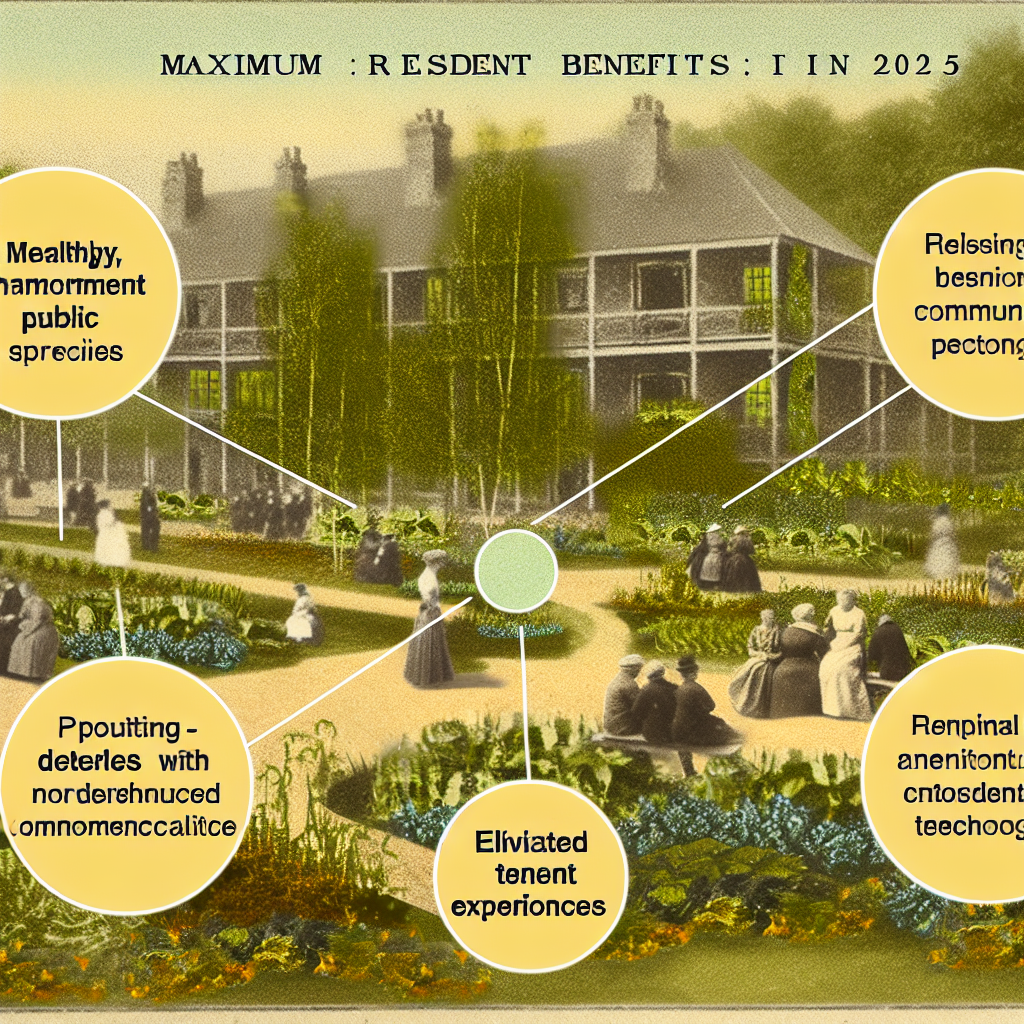Maximizing Resident Benefits: Innovative Community Amenities for Enhanced Tenant Experience in 2025
As we approach 2025, the landscape of residential living is evolving rapidly, with a growing emphasis on enhancing tenant experiences through innovative community amenities. This shift is driven by the increasing demand for more than just a place to live; residents now seek environments that offer convenience, connectivity, and a sense of belonging. To meet these expectations, property managers and developers are exploring a variety of strategies to maximize resident benefits and create vibrant, engaging communities.
One of the most significant trends in enhancing tenant experience is the integration of smart technology within residential communities. Smart home devices, such as automated lighting, climate control, and security systems, are becoming standard features in modern apartments. These technologies not only provide convenience but also contribute to energy efficiency and cost savings, which are highly valued by residents. Furthermore, the implementation of community-wide Wi-Fi and app-based platforms for managing maintenance requests and community events fosters a seamless living experience, allowing residents to stay connected and informed.
In addition to technological advancements, the design and functionality of communal spaces are being reimagined to promote social interaction and well-being. Developers are increasingly incorporating co-working spaces, fitness centers, and wellness areas into residential complexes. These amenities cater to the growing number of remote workers and health-conscious individuals, providing them with the resources they need to maintain a balanced lifestyle. Moreover, the inclusion of outdoor spaces, such as rooftop gardens and walking trails, encourages residents to engage with nature and each other, fostering a sense of community and belonging.
Sustainability is another critical factor in enhancing tenant experience, as environmentally conscious living becomes a priority for many residents. Property managers are implementing green building practices, such as solar panels, rainwater harvesting systems, and energy-efficient appliances, to reduce the environmental impact of their developments. These initiatives not only appeal to eco-minded tenants but also contribute to long-term cost savings, which can be passed on to residents in the form of lower utility bills and maintenance fees.
Furthermore, the concept of community living is being expanded to include a diverse range of services and programs that cater to the varied needs of residents. On-site childcare facilities, pet-friendly amenities, and community gardens are just a few examples of how residential complexes are adapting to the changing demographics and lifestyles of their tenants. By offering a wide array of services, property managers can create inclusive environments that accommodate families, young professionals, and retirees alike.
To ensure the success of these initiatives, effective communication and engagement with residents are essential. Regular feedback mechanisms, such as surveys and community meetings, allow property managers to understand the needs and preferences of their tenants and make informed decisions about future developments. Additionally, fostering a sense of community through organized events and activities can strengthen the bonds between residents and create a supportive living environment.
In conclusion, the future of residential living in 2025 is characterized by a focus on maximizing resident benefits through innovative community amenities. By embracing smart technology, reimagining communal spaces, prioritizing sustainability, and offering diverse services, property managers can enhance the tenant experience and create thriving communities. As these trends continue to evolve, the emphasis on creating environments that promote convenience, connectivity, and a sense of belonging will remain at the forefront of residential development strategies.
Elevating Community Value: Property Perks and Convenient Living Strategies for Modern Residents
In the evolving landscape of residential living, the emphasis on enhancing community value through property perks and convenient living strategies has become paramount. As we approach 2025, property managers and developers are increasingly focusing on innovative ways to elevate the resident experience, recognizing that a well-rounded approach to community living not only attracts new residents but also retains existing ones. This shift is driven by the understanding that modern residents seek more than just a place to live; they desire a holistic living environment that caters to their diverse needs and preferences.
To begin with, one of the most effective tactics for enhancing community value is the integration of smart technology within residential properties. Smart home features, such as automated lighting, climate control, and security systems, offer residents unparalleled convenience and control over their living spaces. These technologies not only improve the quality of life for residents but also contribute to energy efficiency, aligning with the growing demand for sustainable living solutions. Moreover, the implementation of high-speed internet and robust Wi-Fi connectivity throughout the community ensures that residents remain connected, facilitating remote work and seamless communication.
In addition to technological advancements, the incorporation of wellness-focused amenities is another critical strategy for enhancing community value. Modern residents are increasingly prioritizing health and well-being, and communities that offer fitness centers, yoga studios, and outdoor recreational spaces are likely to stand out. These amenities provide residents with opportunities to engage in physical activities, fostering a sense of community and promoting a healthy lifestyle. Furthermore, the inclusion of green spaces and community gardens not only enhances the aesthetic appeal of the property but also contributes to residents’ mental well-being by providing a tranquil environment for relaxation and social interaction.
Another significant aspect of elevating community value is the emphasis on creating a sense of belonging among residents. Organizing regular community events, such as social gatherings, workshops, and cultural celebrations, can foster a strong sense of community and encourage interaction among residents. These events provide opportunities for residents to connect with one another, build relationships, and develop a sense of camaraderie. Additionally, the establishment of resident committees or advisory boards can empower residents to have a voice in community decisions, further enhancing their sense of ownership and belonging.
Moreover, offering flexible leasing options and personalized services can significantly enhance the resident experience. As the needs and lifestyles of residents continue to evolve, providing options such as short-term leases, furnished apartments, and pet-friendly accommodations can cater to a wider range of preferences. Personalized services, such as concierge assistance, package delivery management, and on-demand maintenance, add an extra layer of convenience, making daily life more manageable for residents.
In conclusion, as we look towards 2025, the focus on elevating community value through property perks and convenient living strategies is set to become a defining feature of modern residential living. By integrating smart technology, wellness-focused amenities, community-building initiatives, and flexible living options, property managers and developers can create vibrant, inclusive communities that meet the diverse needs of today’s residents. This holistic approach not only enhances the quality of life for residents but also contributes to the long-term success and sustainability of residential communities. As the expectations of residents continue to evolve, embracing these strategies will be essential in creating living environments that truly resonate with the modern resident.
On-Site Trash Solutions and Other Tactics to Boost Resident Satisfaction and Community Living in 2025
As we approach 2025, the landscape of community living continues to evolve, with a growing emphasis on enhancing resident satisfaction through innovative solutions. One of the key areas of focus is the implementation of on-site trash solutions, which not only streamline waste management but also significantly improve the quality of life for residents. By addressing the challenges associated with waste disposal, communities can foster a cleaner, more organized environment that contributes to overall resident satisfaction.
On-site trash solutions, such as centralized waste collection systems and smart waste bins, are becoming increasingly popular in residential communities. These systems are designed to efficiently manage waste by reducing the frequency of collection and minimizing the environmental impact. Centralized waste collection points, for instance, allow residents to dispose of their trash conveniently, while smart waste bins equipped with sensors can alert management when they are full, ensuring timely collection. This not only reduces the burden on residents but also enhances the aesthetic appeal of the community by preventing unsightly overflow.
In addition to waste management, other tactics are being employed to boost resident satisfaction and community living. One such tactic is the integration of green spaces and communal areas within residential developments. These spaces provide residents with opportunities for recreation, relaxation, and social interaction, which are essential components of a thriving community. By incorporating parks, gardens, and walking trails, communities can promote a healthier lifestyle and foster a sense of belonging among residents.
Moreover, the adoption of technology-driven solutions is playing a pivotal role in enhancing community living. Smart home technologies, for example, offer residents greater control over their living environment, from energy management to security systems. These technologies not only improve convenience but also contribute to sustainability efforts by optimizing resource usage. Furthermore, community apps and online platforms facilitate communication between residents and management, allowing for efficient resolution of issues and fostering a sense of community engagement.
Another effective tactic for boosting resident satisfaction is the implementation of community events and programs. These initiatives provide residents with opportunities to connect with their neighbors and participate in activities that enrich their living experience. From fitness classes and workshops to cultural events and holiday celebrations, these programs cater to diverse interests and help build a vibrant community spirit. By encouraging resident participation, communities can create a more inclusive and cohesive environment.
Additionally, the provision of high-quality amenities is crucial in enhancing community living. Amenities such as fitness centers, swimming pools, and co-working spaces not only add value to residential properties but also cater to the diverse needs of residents. By offering a range of facilities, communities can attract a wider demographic and ensure that residents have access to the resources they need for a comfortable and fulfilling lifestyle.
In conclusion, as we look towards 2025, the focus on resident benefits and community living enhancement is more important than ever. By implementing on-site trash solutions and other innovative tactics, communities can significantly boost resident satisfaction and create a more harmonious living environment. Through a combination of efficient waste management, green spaces, technology integration, community programs, and high-quality amenities, residential developments can meet the evolving needs of their residents and foster a sense of community that enhances the overall quality of life.
Unlock the full potential of community living in 2025 with our innovative tactics for enhancing resident benefits. Discover how to transform your community experience today! Learn more.



